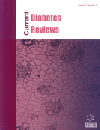- Home
- A-Z Publications
- Current Diabetes Reviews
- Previous Issues
- Volume 6, Issue 5, 2010
Current Diabetes Reviews - Volume 6, Issue 5, 2010
Volume 6, Issue 5, 2010
-
-
Glucose Intolerance and Diabetes Mellitus in Endocrine Disorders - Two Case Reports and a Review
More LessAuthors: M. A. Adlan, L. N.R. Bondugulapati and L. D.K.E. PremawardhanaImpaired glucose tolerance and diabetes mellitus are a manifestation of several well recognised endocrine disorders. Hyperglycaemia subsides upon removal of the underlying cause in these conditions - usually a hormone secreting tumour. We describe two subjects who were cured of their poorly controlled diabetes mellitus following surgical removal of a phaeochromocytoma and a cortisol secreting adrenal adenoma and r Read More
-
-
-
Gene Therapy to Improve Pancreatic Islet Transplantation for Type 1 Diabetes Mellitus
More LessPancreatic islet transplantation is a promising treatment option for Type 1 Diabetics, offering improved glycaemic control through restoration of insulin production and freedom from life-threatening hypoglycaemic episodes. Implementation of the Edmonton protocol in 2000, a glucocorticoid-free immunosuppressive regimen has led to improved islet transplantation success. >50% of islets are lost post-transplantation primaril Read More
-
-
-
Dysregulation of Glycogen Synthase Kinase-3 in Skeletal Muscle and the Etiology of Insulin Resistance and Type 2 Diabetes
More LessInsulin resistance of glucose transport and metabolism in insulin-sensitive tissues is a primary defect leading to the development of type 2 diabetes. While the etiology of insulin resistance is multifactorial, one factor associated with reduced insulin action is enhanced activity of the serine/threonine kinase glycogen synthase kinase-3 (GSK-3) in skeletal muscle, liver, and adipose tissue. GSK-3 is involved in numerous c Read More
-
-
-
Is Inflammation a Common Retinal-Renal-Nerve Pathogenic Link in Diabetes?
More LessAuthors: Kirti Kaul, Andrea Hodgkinson, Joanna M. Tarr, Eva M. Kohner and Rakesh ChibberThe global diabetes burden is predicted to rise to 380 million by 2025 and would present itself as a major health challenge. However, both Type 1 and Type 2 diabetes increase the risk of developing micro-vascular complications and macro-vascular complications which in turn will have a devastating impact on quality of life of the patients and challenge health services Worldwide. The micro-vascular complications that affe Read More
-
-
-
Angiogenic Growth Factors and their Inhibitors in Diabetic Retinopathy
More LessDiabetic retinopathy is considered one of the vision-threatening diseases among working-age population. The pathogenesis of the disease is regarded multifactorial and complex: capillary basement membrane thickening, loss of pericytes, microaneuryms, loss of endothelial cells, blood retinal barrier breakdown and other anatomic lesions might contribute to macular edema and/or neovascularization the two major and Read More
-
-
-
Intravitreal Bevacizumab (Avastin®) for Diabetic Retinopathy at 24-months: The 2008 Juan Verdaguer-Planas Lecture
More LessDiabetic retinopathy (DR) remains the major threat to sight in the working age population. Diabetic macular edema (DME) is a manifestation of DR that produces loss of central vision. Proliferative diabetic retinopathy (PDR) is a major cause of visual loss in diabetic patients. In PDR, the growth of new vessels is thought to occur as a result of vascular endothelial growth factor (VEGF) release into the vitreous cavity as a response to Read More
-
-
-
Disturbance of Inorganic Phosphate Metabolism in Diabetes Mellitus: Its Impact on the Development of Diabetic Late Complications
More LessAuthors: Jorn Ditzel and Hans-Henrik LervangThe pathogenesis of diabetic late complications (DLC) is multifactorial. Studies of mechanisms leading to early functional microvascular changes in retina and kidneys point towards a disturbance in the metabolism of inorganic phosphate (Pi) in diabetes. Since tissue hypoxia and reduced high energy phosphates may be important factors in the development of DLC, the influence of Pi concentration on the metabolism and functi Read More
-
-
-
Shoulder Manifestations of Diabetes Mellitus
More LessAuthors: Cintia Garcilazo, Javier A. Cavallasca and Jorge L. MusuruanaThe musculoskeletal system can be affected by diabetes in a number of ways. The shoulder is one of the frequently affected sites. One of the rheumatic conditions caused by diabetes is frozen shoulder (adhesive capsulitis), which is characterized by pain and severe limited active and passive range of motion of the glenohumeral joint, particularly external rotation. This disorder has a clinical diagnosis and the treatment Read More
-
-
-
Interrelationships between Hepatic Fat and Insulin Resistance in Non- Alcoholic Fatty Liver Disease
More LessAuthors: Khalida A. Lockman and Moffat J. NyirendaNon-alcoholic fatty liver disease (NAFLD) is strongly associated with insulin resistance, and its prevalence is rising in parallel with worldwide increases in obesity and type 2 diabetes. However, the nature of this relationship remains debatable. In particular, it is unclear whether insulin resistance causes NAFLD or hepatic steatosis per se reduces insulin sensitivity. This review will examine data from recent studies on the l Read More
-
Volumes & issues
-
Volume 21 (2025)
-
Volume 20 (2024)
-
Volume 19 (2023)
-
Volume 18 (2022)
-
Volume 17 (2021)
-
Volume 16 (2020)
-
Volume 15 (2019)
-
Volume 14 (2018)
-
Volume 13 (2017)
-
Volume 12 (2016)
-
Volume 11 (2015)
-
Volume 10 (2014)
-
Volume 9 (2013)
-
Volume 8 (2012)
-
Volume 7 (2011)
-
Volume 6 (2010)
-
Volume 5 (2009)
-
Volume 4 (2008)
-
Volume 3 (2007)
-
Volume 2 (2006)
-
Volume 1 (2005)
Most Read This Month
Article
content/journals/cdr
Journal
10
5
false
en


